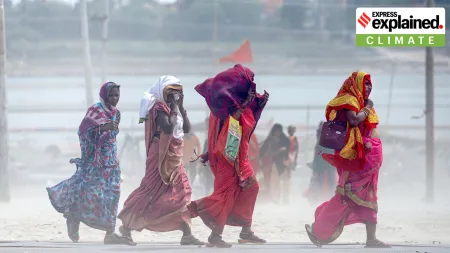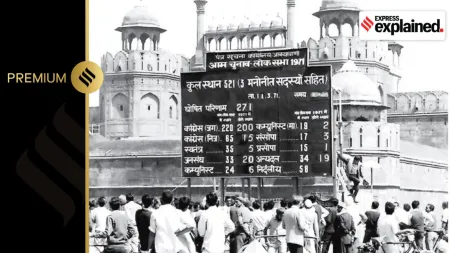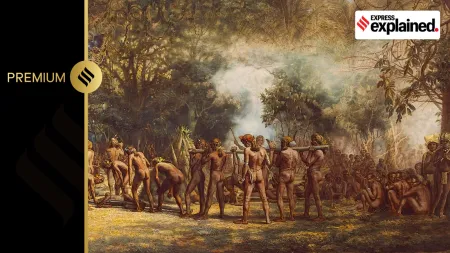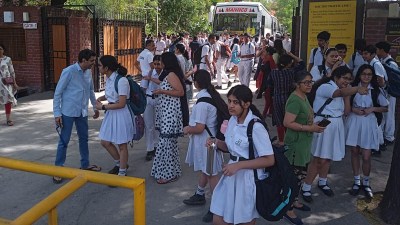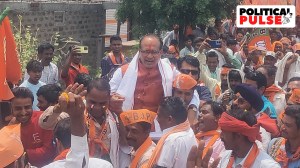- India
- International
Birds Without Borders: Indian peafowl or peacock, the epitome of beauty is a demanding partner
The Indian peafowl holds a special place in Indian culture. The bird features prominently in motifs in people’s houses and was even used to adorn the thrones of many kings in medieval India.
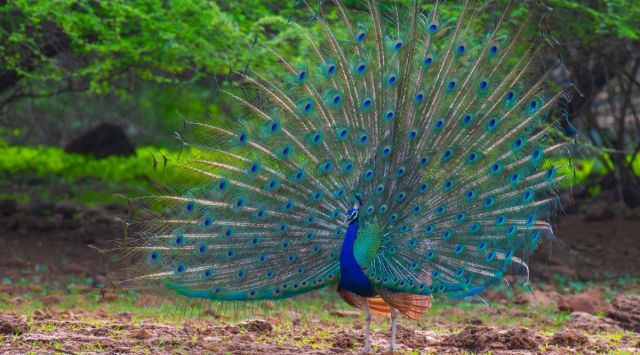 Peacocks shed their train feathers periodically and during such phases, without their long feathers, they don’t look all that beautiful and look somewhat similar to peahens in size. (Credit: Dr Jayendra Bhalodiya)
Peacocks shed their train feathers periodically and during such phases, without their long feathers, they don’t look all that beautiful and look somewhat similar to peahens in size. (Credit: Dr Jayendra Bhalodiya) Have you ever wondered how birds express themselves? Some do so with their singing, some by dancing, others with their pompous gait etc. But if you observe a peacock, also called Indian peafowl (Pavo cristatus), you will realise that this majestic bird can use several methods at a time to express itself. For example, during the courtship display, a male Indian peafowl spreads his train feathers like a fan and gorgeously displays his ornamental feathers. He also makes gracious moves with his feet to approach the female (peahen) while keeping his long train feathers spread. Not only that, he claps his brown wings below the tail to make a sound and shakes his white feathers of wings to create a tremble. These trembles are so strong that you can easily hear the rustling shake from a distance. Thus, it engages various senses like visual, audio, behavioural, and maybe more to attract the peahen.
During the breeding season, a peacock mates with multiple peahens. Moreover, when a peacock wants to make a resonating sound, he folds his attractive iridescent blue neck all the way to his stomach and releases it by producing a louder voice, especially at sunrise or sunset during the monsoon. Their call is ‘may-awe’. If a peacock makes an alarming call, his neighbours make a joining call.
The Indian peafowl holds a special place in Indian culture. The bird features prominently in motifs in people’s houses. It even used to adorn the thrones of many kings in medieval India. Male singers with attractive voices are often compared to a peacock. In many parts of Gujarat, there is a popular belief that it rains if a peacock makes repeated calls of ‘may-awe’ – phonetically similar to ‘meh aav’ which, in Gujarati, means ‘do come, rain god’. The beauty of peacock feathers has inspired many artists and such prints are used in clothes by craftsmen and textile industries. Given his beauty and cultural importance, it is no wonder that the peacock is the National Bird of India.
 The Indian peafowl holds a special place in Indian culture. The bird features prominently in motifs in people’s houses. (Credit: Dr Jayendra Bhalodiya)
The Indian peafowl holds a special place in Indian culture. The bird features prominently in motifs in people’s houses. (Credit: Dr Jayendra Bhalodiya)
Peacock feathers are also considered auspicious. Temples, dargahs, gurudwaras and agiyaris (fire temples, places of worship for followers of Zoroastrianism) etc. use ornamental brooms made of peacock feathers to clean within the premises. Such brooms must be made of feathers that have been shed by a peacock on his own and not plucked by some poacher. The peacock is also a vehicle of Goddess Saraswati, the Hindu deity of knowledge.
A peacock’s train feathers are quite long. Hence, the overall length of a peacock is about 3.5 metres. Peacocks shed their train feathers periodically and during such phases, without their long feathers, they don’t look all that beautiful and look somewhat similar to peahens in size. However, even without train feathers, males can still be easily differentiated from females thanks to their iridescent blue necks as compared to the iridescent green necks of females.

Peahens do not have long feathers but they do have a greenish shade on the lower neck. Moreover, peahens are brown and look dull compared to males. Due to her dull colour, a peahen can easily camouflage herself in dry forests for protection.
The Indian peafowl weighs 3 to 6 kg and lives for approximately two decades. Despite such length and weight, it is capable of flying. It also has a beautiful crest made up of wire-like thin feathers in a fan shape.
Indian peafowls are resident breeders in India. In Gujarat, they are found everywhere and happily co-exist even in urban residential complexes in Ahmedabad. It is quite common to find them in large numbers in Gir Forest, Osam Hills in Rajkot, Gandhinagar, and many more places. They are a common sight in agricultural fields lined with tall trees. They eat seeds, fruits like bananas, crops like groundnuts, vegetables like chillies and tomatoes, insects, small reptiles including snakes, small mammals, etc. The Indian peafowl also plays a crucial role in the agricultural ecosystem by eating insects such as grasshoppers which otherwise may damage crops.
To protect themselves, Indian peafowls roost in a group on a tree at night. However, they build the nest in grass on the ground which is made up of leaves, sticks, etc. Their breeding is as per the local monsoon season so plenty of food is available when chicks hatch. A peahen lays four to eight eggs and hatches them for 28 days. Sometimes if a bird in a pair gets injured and a wound festers, the other partner helps clean the wound with its beak by plucking the insects and unwanted elements out. However, for all the handsome looks and majestic aesthetics they afford, peacocks do not contribute to incubating eggs or parental duties. It is all left to the peahen after she lays her eggs. After two months, the chicks become independent.
The Indian peafowl often faces hunting threats for its meat and feathers. It also faces the threat of being poisoned due to pesticide-treated seeds and agrochemicals sprayed by farmers to protect their crops. However, their population remains stable. On the IUCN Red List, this species has been categorised as being of Least Concern (LC) so far as its conservation is concerned.
(Dr Jayendra Bhalodiya is an assistant professor at Ahmedabad University. He is affiliated with Bird Conservation Society, Gujarat and Eco Friends Gujarat.)
May 01: Latest News
- 01
- 02
- 03
- 04
- 05


